![]()
We are,
right now, in the midst of another major evolutionary quantum leap. We are in the midst of the transition from Homo sapiens, sapiens to Homo nobilis, stellaris.
The stellaris part is obvious.
When Neil Armstrong stepped upon the surface of the Moon on July 20. 1969, this marked the emergence of our kind from its earthbound cradle into the vast domain of space. For the first time in the history of our kind, human beings have stood upon and left their footprints upon another celestial body - and have seen Earth-rise from the Moon.

footprint on the Moon; Apollo 11; courtesy NASA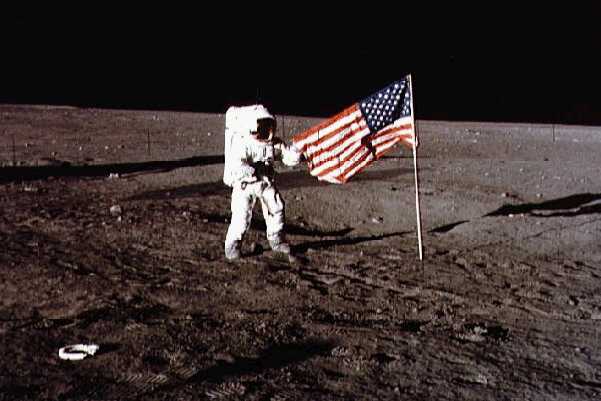
Edwin Aldrin unfurling flag on the Moon; Apollo 11; courtesy NASA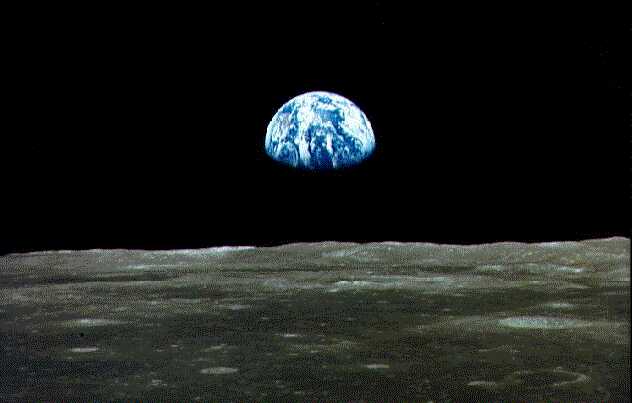
Earth-rise on the Moon; Apollo 11; courtesy NASA
In the mere 27 years since then, we have sent probes to all of the planets
and some of their moons in our solar system, and we have photographed, mapped and analysed their surfaces. Another probe to the surface of Mars is currently on its way (arrived and well, July 4. '97), several other Mars missions are in the development stage, and a manned mission to Mars is being contemplated. Meanwhile, the possibility of terra-forming Mars and making it suitable for permanent human occupation is being investigated.
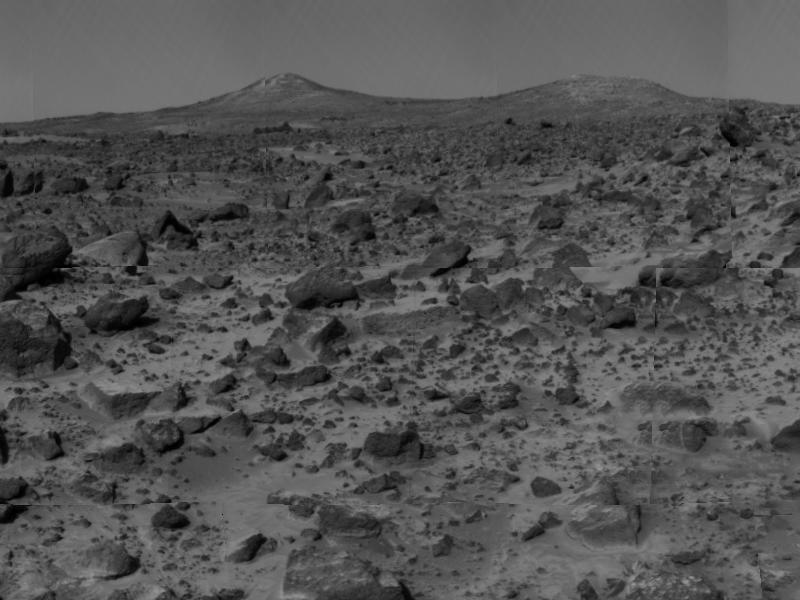
On Mars; "Twin Peaks", Mars Pathfinder mission; July 7. 1997; courtesy NASA
Our fascination with the awesome grandeur of the star-strewn heavens is, naturally, as old as our kind itself.
Even the first of our kind could not help but raise their newly questing eyes under shaggy brows to the light of the stars and search for omens and portents, and bestow some some meaning and purpose among those eternal points of light in the firmament. And the notion that we would go there, if only after we departed this world, has always been the stuff of the myths, the legends, fables and fiction of our kind. However dimly and fancifully in the past, we have always known that the stars are our destiny.

Meanwhile, and also largely within our own time, we have also come to understand the structure, and map the mind-boggling vastness of our universe. We now know exactly where our solar system lies within our home-galaxy, and where our galaxy lies in relationship to billions of other galaxies. We have also come to understand the birth and death of stars, of moons and planets, of our Earth, of quasars and black holes, and we now have innumerable pictures of these vast celestial labours of the cosmos.
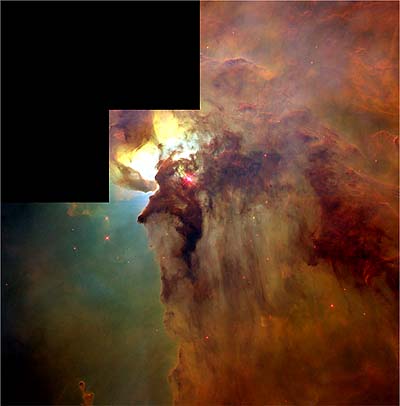
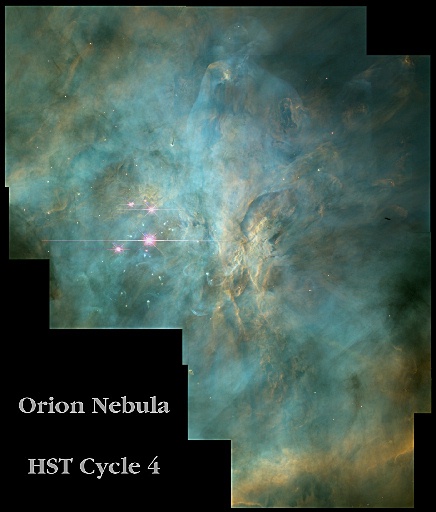
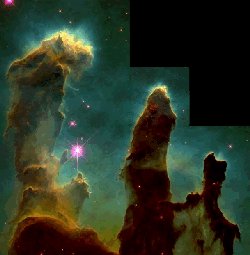
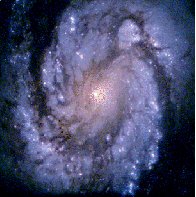
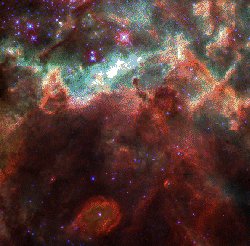
left; star-birth in galaxy M16 - / - centre; spiral galaxy M100 - / - right; 30 Dorados, Large Magellanic Cloud
above images courtesy of Hubble Space Telescope
And we have also come to understand the creation of our universe itself to within split-nano-seconds of its very birth.
Within our own time,
our kind has taken its first steps into the domain of space, and thus crossed the threshold from an earthbound species to a space-faring species. This transition dwarfs, by many orders of magnitude, the making of the first primitive chip which forever and profoundly distinguished our line from the animals, and marked the emergence of the Homo line from its apish antecedents.
We have also come to understand that we are, fundamentally, creatures of this universe, rather than of the Earth. The whole Earth - like all things in this universe - is, after all, a product of this universe; and so is Life. The traditional notion that we are creatures of the Earth, while true, is therefore only a myopically local perception of our existence - as compared to the new perception of the vast cosmic context and universal fabric of our existence.
We now also know and have come to understand that we are composed of elements which were fused in stars, and that we are animated - body and mind - by the energy of a star, our Sun. We are, in Carl Sagan's words, "star-stuff". This has become common knowledge now, and our kids now learn this at school.
Within our time,
our perceptions have catapulted far beyond the local domain of the Earth - the "Small Blue Dot" in space, as Carl Sagan put it - and we now know that the true and ultimate fabric and context of our existence is the immensity and totality of our universe. Not surprisingly then, even our music and entertainment has begun to reflect the cosmic perceptions of Homo stellaris. Much of our 'new age' music is profoundly 'cosmic' in nature and speaks eloquently of the infinite depth and majestic grandeur of the universe. And the vast popularity of the "Star Treck" series and similar space operas speaks for itself. Meanwhile, and inevitably, the focus of our space operas has also changed. Instead of being threatened by 'alien invaders', we have begun to depict ourselves as masters of the cosmos.
This is the knowledge of,
and most importantly, the perception of Homo stellaris, and distinguishes Homo stellaris from Homo sapiens, sapiens - just as the perception and knowledge that a stone can be shaped into a specific tool and be kept for future use, forever distinguished the first of the Homo line from its pongoid cousins. Homo stellaris knows and perceives him- or herself as a member of the human race on the planet Earth, within our solar system, within our home-galaxy of the Milky Way - just one of billions upon billions of other such vast galaxies in the universe - and as a 'child' of the cosmos, the direct product of the universal laws and forces which have created the universe, the Earth, and Life alike.
The nobilis part is just as obvious.
Within our time we have witnessed the rapid growth of the number of people who dedicate their lives to the survival and well being of other people, particularly of children around the world, of the animals, even trees, of the planet as a whole, and of course, on a global scale - and utterly regardless of race, religion, nationality or gender.
This is a vast quantum leap of consciousness over the myopically self-centered concern with the survival and well being of the self - which invariably comes at the expense of others, of our environment, or of our biosphere. This new global consciousness of the unity and sanctity of all Life, of human kind, and of our planetary biosphere is not something that has been acquired or learned; it is inborn. Although often still derided as 'bleeding hearts', 'animal lovers', 'tree huggers' or 'eco-terrorists', these people literally cannot help but do what they do. Their motivations are deep and passionate, and arise out of the very core of their being. They are 'made that way'. For these people, the survival and well being of humans everywhere, of the animals, even of trees, and the planet as a whole takes precedence over their own well being and survival - and many have indeed paid that price. The six Red Cross nurses killed in their beds in Czechnya are just the most recent of many hundreds of such examples.
The concern with the survival and well being of all Life is is a very recent phenomenon.
Most of us have forgotten already that not too long ago, all animals were perceived primarily as food, a few as pets, and the remainder as pests. Within the last 50 years, we have gone from the fully intentional and almost complete extermination of wolves, for example, to devoting much effort and money to re-establishing their presence in their native habitats.
Let us set this evolutionary leap of consciousness in its perspective. All animals defend their food against others to the best of their ability. Even sparrows at the bird feeder try to fend off other sparrows. Among the social animals which hunt and scavenge (our line of origin), the dominant male feeds first, then the other males, then the females, and lastly, the young. Even animal mothers will eat their fill first before yielding any food to their own offspring. This animal legacy of the primacy of the survival of the self still prevails among many people. In stark contrast, Homo nobilis will eat last, or only when satisfied that all others within their personal social matrix are equally provided for. And in times of scarcity, the children of Homo nobilis are fed first. For Homo nobilis the age-old 'struggle for survival' has leapt from the paramount concern with the survival of the self to an overriding concern with the survival and well being of the whole - humankind, whales, animals, birds, flowers, trees, biosphere and all. Simultaneously, and indivisibly, it has also shifted from the exclusive preoccupation with survival in the present to an overriding concern for humankind's survival over the long-term future.
Thus, Homo nobilis has now and forever left behind two deeply ingrained instinctual legacies of our animal antecedents.
The current controversies that divide so many of us in matters of human rights, animals rights, even 'tree rights', the protection of our environment, and so forth, and so forth, arise directly out of the differences of perception and levels of consciousness between Homo sapiens, sapiens and Homo nobilis, stellaris. There is another, and all too familiar difference.
Homo sapiens, sapiens performs 'indiscriminate acts of violence'; Homo nobilis stellaris performs 'indiscriminate acts of kindness'.
To obtain an insight into the sheer magnitude of our current evolutionary quantum leap - and also an indication of the stunning vastness of Homo nobilis, stellaris' domain and future - we need to take a brief look at the major milestones of the evolution of the human line.
The advent of bi-pedalism, or walking on the two hind limbs, about 4 million years ago, was long considered to be the evolutionary hallmark of the emergence of the homonoid line. And while it is true that we are direct descendants of fully bi-pedal animals, we share this feature with all birds, the ostrich, the kangaroo, even many dinosaurs, as well as some modern lizards. Australopithecines, the immediate precursors of Homo, and the evolutionary 'link' between the great apes and the Homo line, were efficiently bi-pedal. However, these precursors of Homo are rightfully classified as Australopithecus, and not Homo.
And while the fossil record remains very patchy at best, and interpretations differ widely, the modern classification of Homo begins about 2.5 million years ago, with the evolutionary advent of Homo ergaster - the 'enterprising' human. This is the newest line of thought regarding human origins, based on a spate of recent discoveries which have pushed back the origin of the hominid line a lot further into the past. According to this view ("Out of Africa Again...and Again"; SCIENTIFIC AMERICAN, April, 1997). Homo ergaster evolved from Australopithecus afarensis (as represented by the famous 'Lucy'), and then gave rise to Homo erectus, and a little later, to Homo heidelbergensis. Homo heidelbergensis spawned first Homo neanderthalis, and eventually, Homo sapiens. Finally, and between 40- to 30 thousand years ago, Homo sapiens, sapiens evolved from Homo sapiens, and eventually replaced all the other, and now long extinct lines of Homo.
The distinguishing features of Homo ergaster are a larger brain (about 800 milliliters, as compared to 'Lucy's 400 milliters, and modern man's average 1400 milliliters), fully bi-pedal walk, the conceiving and making of tools - as opposed to the simple use of whatever lies at hand as a tool; but most importantly, the adaptation to open, non-forested lands. Homo ergaster was as much at home on the open savannah as in the forests. It is chiefly this adaptation which resulted in spread of Homo far beyond Africa in several migrations, and far earlier than hitherto thought. This solves the conumdrum of the sudden appearance and subsequent speciation of Homo in lands as far away from Africa as Java and China ("Peking man") without any known local antecedents.
Larger brains, upright walk, and the ability to make tools are all valid indicators of highly advanced levels of evolution, but none of these are unique to humankind. Dolphins, whales and elephants all have larger, and more convoluted brains than we do; but they do not fashion tools, build cities, establish nations, sail the oceans, the skies and space, make hydrogen bombs, have TV, nor invent and use computers. And as mentioned, we share upright walk with many other animals, now living or extinct. This leaves the capacity to make tools.
While some animals use tools - otters use a stone to crack shells, gorillas use a stick to fish for honey, for instance - the conceiving and making of a tool for a specific purpose - and keeping it - signals a huge leap in cognitive consciousness over that of the animals. This point is so important that it bears a bit of elaboration.
The ability to envision a specific tool for a specific purpose, then setting about patiently crafting such a tool many days beforehand and, most importantly, then permanently keeping this tool for envisioned future occasions - is such a vast leap in cognitive consciousness over simply picking up a handy stone or twig when needed, and blithely discarding it when done, that it truly marks an evolutionary quantum leap over the simple use of tools.
However, and as it now turns out, the ability to make tools is not unique to humankind either.
Take the crows of the island of Caledonia, for instance. These crows - of all people - also make tools!
The Caledonian crows make two kinds of carefully selected and patiently shaped tools. One is a stick with a hook, made by breaking a carefully selected small branch from a plant, stripping it of all leaves, and then patiently nibbling at the end of the stick to form a hook. The other tool is made by tearing a leaf from a tough, sawtooth-edged grasslike plant, and then carefully stripping away sections of the leaf to create a sturdy, long and sharply pointed wedge. Both tools are used to fish for small insects under debris and in the knotholes of trees. Gavin Hunt, of Massey University in New Zealand says: "It all seems very logical. These guys know what they are doing." ("Avis habilis"; DISCOVER MAGAZINE, Jan. 1997).
And these crows do this with a brain about one-half the size of a peanut. Obviously then, the size of brain, and the making of tools, are not infallible indicators of a high level of cognitive evolution.
What distinguishes Homo from all of the animals is the emergence of mind, of logic and reason,
of a complex language, of a profound awareness of self and empathy with others, within the context of past, present and future. Since our acute cognitive awareness is the cardinal and distinguishing feature which sets us apart from all animals, we shall follow the milestones of cognitive evolution rather than physiological and neural evolution. In the opinion of this writer, the milestones of cognitive evolution have changed and defined the course and matrix of our existence, and affected the further evolution of our kind far more so than any physiological and neural features, and thus are far more accurate indicators of the evolution of our kind.
2) The domestication of organic fire
by Homo heidelbergensis, about 1/2 million years ago. This advent is deeply significant. All animals are instinctually terrified by fire. So were the ancestors of our kind. To not only overcome this innate terror of fire, but to domesticate it, is indisputable evidence of the evolution of reason, and of logic. Only reason can overcome the deeply innate terror of fire, and only a careful logic can domesticate it. Of course, the acquisition and domestication of fire has profoundly affected the course of the evolution of our kind. For one, it allowed Homo heidelbergensis to expand into the temperate regions of the old world, where survival over the cold winter was made possible only by the maintenance of domestic fire, along with such preserved foods as smoked meat and fish.
3) The invention of math
Math was invented, about 40.000 years ago, by the females of Homo sapiens, sapiens out of two necessities; of calculating and being prepared for their menstrual cycles and, as the principal gatherers of edibles, for the vital necessity of correctly estimating the times of maturity and harvestability of fruit, nuts, berries, greens and tubers. Their survival dependent on this. Although it consisted only of simple counting at that time, it nevertheless laid the foundation for all of our math.
And while some of our simian relatives appear to have a dim awareness of lesser or greater quantity, the capability of counting is forever beyond them. Even among the most primitive surviving tribes of our kind, the ability to count does not go further than one, two and many. Thus, the ability to track menstrual and seasonal cycles by their numbers marks the advent of a new and far higher level of cognitive consciousness.
4) The advent of cave art
in the form of sophisticated paintings and engravings - and the first primitive precursors to writing in the form of symbolic figures and signs - about 32.000 years ago. This evolutionary milestone marks the advent of nothing less than abstract thought - the newly evolved capacity to convey and derive meaning via symbols, and most importantly, in the absence of the physical presence of the object depicted.
Since only great importance can justify the considerable time, effort and expenditure of resources demanded by these deeply hidden cave paintings and engravings - light alone consumed considerable valuable resources - we can safely conclude that cave art occupied a central and powerful mythological position in the lives of these people of our own kind. Consequently, it is clear that H. sapiens, sapiens had evolved to a level of consciousness which placed H. sapiens, sapiens into a transcendental context and hierarchy of higher powers. H. sapiens, sapiens had become conscious of the realm of 'spirit'.
5) The invention of agriculture
and shortly thereafter, of animal husbandry, about 11.000 years ago. This is another major milestone in cognitive evolution since it required several totally new concepts. The recognition of seeds and their function; the saving of seeds (food) for seeding in the next growing season; of nursing and tending plants to maturity in anticipation of a future harvest; and most importantly, of dedicating present activities to a distant and uncertain future.
The invention of agriculture also resulted in the profound change from nomadic hunter-gatherers to settled communities, land ownership, the advent of villages, specialization into trades, seed and surplus storage and management, record keeping, village elders, and unavoidably perhaps, the advent of municipal politics. With the invention of agriculture, H. sapiens, sapiens had laid the foundation for our modern civilizations.
6) The invention of metallurgy
about 8.000 years ago, by the people of the lower Danube. H. sapiens, sapiens had begun to be aware of and employ the laws of nature as embodied in chemistry. It also gave humankind its first and far superior metal tools and implements, and laid the foundation for the technologies of kind.
7) The invention of the wheel
about 5.500 years ago in Mesopotamia, shortly after the invention of the pottery wheel. It was the beginning of land transportation technology, of roads, and thus, of much of our modern technology and civilisation. Far more importantly though, Homo sapiens, sapiens had begun to be aware of, and use, the 'laws of nature'. Besides laying the foundation for the extraction of energy from natural forces (waterwheel, windmill, hydro-electric power), it also laid the foundation for Homo nobilis, stellaris - since 'the laws of nature' are also the laws of the universe.
8) The invention of writing
- H. sapiens, sapiens' first cognitive tool - about 5.000 years ago, also by the Sumarians of Mesopotamia. It marks our kind's full entry into the abstract domain of symbols, and the capacity to convey meaning and information via symbols. Many would argue that this is not an evolutionary, but a learned phenomenon. This is not so. Even our 1-1/2 year-olds innately recognize and attach meaning to pictures. It is in our genes. Writing would provide the foundation of all of the history, math, science, monetary systems, literary arts, teaching and mass-communication of our civilisations.
9) The acquisition of chemical fire
in the form of fire-crackers, about 1.000 years ago, in China. This marks the entry of H. sapiens, sapiens into the domain of chemical fire and added another kind of fire (gunpowder, TNT, gasoline, acetylene, rocket fuel, matches, etc.) to humankind's growing repertoire of fires. Most of today's technology rests on our capability to make and harness chemical fire.
10) The harnessing and use of electrical fire
about 130 years ago. Although the nature of electricity was described in a research paper by William Gilbert in the year 1600, and many ground-breaking discoveries followed over the next two hundred years, we shall take the first practical application of electricity - in telegraphy in the year 1837 following Morse and Wheatstone's discoveries - as the beginning of the electrical age. H. sapiens, sapiens had added yet another 'fire', or source of energy, to his repertoire of domesticated fires.
This acceleration of cognitive evolution is paralleled in the biological process of the evolution of Life itself. The first traces of Life on the Earth arose almost 4 billion years ago. Yet the evolution from simple one-celled organisms to the immense complexity of our kind occurred only within the last 1/2 billion years. And if we compare the almost 4 billion year-long process of the evolution of Life to a 12 hour period, then the Homo line emerged only 18.6 seconds ago.
Far from having come to a grinding halt with the advent of Homo sapiens, sapiens
- as some people think - the acceleration of evolution continues unabated. On the contrary; one could say that evolution is just now shifting into high gear. To illustrate this point, we will now turn to the milestones of the cognitive evolution of our kind within this century.
1) The discovery of the nuclear force
by Albert Einstein, as described in his famous E=mc^2, and his recognition that light can behave either like waves - or like particles, in his special theory of relativity, in 1905. This marks H. sapiens, sapiens' cognitive penetration deep into the fundamental laws and forces of our universe.
2) The discovery of quantum physics
by Neils Bohr in 1913, with his recognition of the quantum nature of energy. His discovery catapulted H. sapiens, sapiens into the new domain of quantum physics - into the microcosmic heart and core of energy and matter - and deeper into the fundamental laws and nature of our universe. H. sapiens, sapiens' cognitive awareness now includes the former secret of the birth of our universe itself.
3) The harnessing of nuclear fission
with Enrico Fermi's first demonstration of nuclear fission in 1934. H. sapiens, sapiens had acquired, for better and for worse, yet another fire - and this time, star-fire itself - the nuclear fire that rages at the core of every star in the universe. H. sapiens, sapiens had created, and then used, miniscule and momentary stars on the Earth. However great a cognitive achievement this may be, this writer believes that we will find out that star-fire is entirely inappropriate on the Earth.
4) The invention of our first mind-tool
with the construction of the first electronic all-purpose computer (called ENIAC) in 1946 by Eckert and Mauchly, at the University of Pennsylvania. And while many earlier inventions - from Blaise Pascal's first calculator (1642) to Babbage's 1820s concepts for the "Difference Engine" led up to ENIAC, we shall take ENIAC's unique all-purpose capacity as the defining marker which signalled the advent and use of H. sapiens, sapien's newest tool - "man the tool-maker's" first mind-tool.
We need to take a moment here to set H. sapiens, sapiens' newest tool into its perspective. Until ENIAC, all of our tools were hand-tools. Even our most sophisticated automated machines are essentially hand-tools, used for, and limited to processing materials. ENIAC was the first machine which processed information. H. sapiens, sapiens had acquired the first mind-tool of our kind.
There is a vast distinction between the finite realm of material processing, and the infinite realm of information processing. ENIAC marks nothing less than the advent of the new Age of Mind-tools. Anthropologists of the far flung future will divide human evolution into two phases; the Age of Hand-tools; and the Age of Mind-tools. Today, we are just at the very beginning of the Age of Mind-tools, and much at the same stage with our electronic chips as Homo ergaster was with his stone chips. And what the future of the Age of Mind-tools will bring is just as unimaginable to us now - as our time is to the shapers of the first flint.
Other than this, there simply is no comparison. Mind-tools operate on an entirely different, and far higher level of cognitive consciousness than hand-tools. It simply is not the same ball game. And the changes the Age of Mind-tools will bring to our civilisations will dwarf all the changes Homo has ever experienced as the result of his inventions - by many orders of magnitude. These changes will happen very, very fast. In fact, vast changes are well underway already. 'The Information Age' is profoundly restructuring many cultures of the Earth already - despite much strong resistance. Since the prime function and purpose of cultures is to provide abiding social stability for their people, this will result in much turmoil, and far more than we have seen already. Still, and in a few decades, we will look back at our time as the end of "The Dark Ages".
5) The deciphering of the double helix of DNA
by Crick and Watson, in 1953. Homo sapiens, sapiens has now acquired the ability to change the very life-codes of all living things to his design - in other words, to play god. And we have done it already; we have created many strains of genetically engineered bacteria, as well as genetically engineered mice - even engineered mice which are growing human appendages, such as a human ear, on their backs. And most recently, we have managed to clone sheep and monkeys. Meanwhile, many of us are eating genetically engineered fruit already. We have not only become active agents in the process of evolution, but we have given it our own new directions, and speeded it up to practically overnight. Nature takes hundreds of thousands of years to evolve a new species; we can now do it in a few months.
6) Humankind's entry into the Space Age
as marked by Armstrong's first step onto the surface of our moon, on July 20. 1969. For the first time, humans have stood upon and left their footprints, along with the inevitable garbage, on another celestial body. This marks humankind's entry into the domain of space, and the transition from H. sapiens, sapiens to H. sapiens, stellaris.
Six major evolutionary milestones in 64 years,
in a bit less than one average human life-time - in less than a blink, so to speak, of an evolutionary eye - and all of them dwarf anything that our kind has ever done before.
We can truly say that never have so many done so much in such a short time.
Humankind now functions within a cognitive context that far transcends, and bears very little resemblance to the cognitive awareness of the turn of the last century. We have come from what amounts to the almost mediaeval perceptions of horse-and-buggy days to the cosmic perceptions of Man on the Moon in one life-time. It is almost, not quite but almost, as if humankind has gone from the awareness of a child to that of a knowledgeable adult overnight. Today, we are a far different people than those of the turn of the century. And far from having come to a grinding halt, cognitive evolution has indeed shifted into high gear in our time - and it will continue to accelerate exponentially.
Still, and as vast and powerful as these great quantum leaps in cognitive consciousness are,
this is not all, by any means. It appears that biological evolution is taking just as large a quantum leap as cognitive evolution. To whit.
Over the last few decades, Northern Europeans have been growing taller by an inch per decade. This has become a bit of a problem in negotiating standard sizes for the height of chairs and tables, the length of bed and bedding, head room in cars, and so forth and so forth, among the nations of the European Common Market. Purely nutritional causes appear to be ruled out since nutrition is uniformly good all across Europe.
The experts in these matters have also noticed that the human brain appears to be getting larger again. Since this is a very recent phenomenon, it is impossible to say whether this is a random spike within the normal fluctuation of human brain sizes, or whether this is a true evolutionary trend. Given the glacially slow pace of biological evolution - if only from our personal temporal perspective - we will know with certainty in another 5 to 10 thousand years.
Nevertheless, I personally know two little girls (three year-olds) within my circle of family and friends
whose acute intelligence has left me stunned on many occasions. Although the progeny of very average parents and entirely ordinary upbringing, the perceptions of one three year-old can be best described as an 11 year-old Ann Landers (she is fascinated with relationships), and the other three year-old can be best described as an 8 year-old naturalist (her fascination lies with everything that lives). It is very hard to believe that both of these little girls are only three years old. And this does not appear to be an isolated phenomenon. Almost everyone I talk to about these things knows of one or more similar cases in their circles of family and friends. And sixteen year-olds with doctorates, and similar unusually high achievements, are making the news with increasing frequency.
Yet, there is yet another, and readily visible phenomenon which none of the evolutionary experts,
or anyone else, at least as far a I know, had foreseen. Larger craniums and smaller faces are the usual evolutional features forecasts by the experts. But none have even mentioned the now wide-spread appearance of such an exquisitely graceful articulation of the fingers among females that it leaves this writer agape. It speaks eloquently, and far better than mere words, of a natural and un-conscious grace of spirit - of a grace of being - that is breathtaking to behold. Let it be noted that this newly emergent astonishing gracefulness of finger articulation goes far beyond the normal gracefulness of female finger movement. And one can see it everywhere, and in all races. At the supermarket, on the TV, in school, at work, among family and acquaintances; in short, everywhere.
Another newly emergent phenomenon is a similar breathtaking gracefulness
of the proportions of limbs in females. Although not yet as frequent and as obvious as the new exquisitely graceful articulation of female fingers, it has left this writer agape with astonishment on several occasions.
It now appears that evolution is now also bestowing an exquisitely beautiful gracefulness
of physical appearance and movement upon our kind - to culminate in a grace of body, mind and spirit which goes leagues beyond anything that we have known so far. And while this may be entirely unforeseen by us, it nevertheless stands to reason. It should not come as a surprise that the essential grace of spirit of Homo nobilis should also come to be fully expressed in physical form and motion.
Given the exponentially escalating pattern of the whole evolution of Life,
and given the unprecedented close cluster of the vast quantum leaps in cognitive evolution in our time; and given the strongly emergent features of further biological evolution of our time; and given the equally strongly emergent concern for the survival and well being of the all of the people, animals, even trees of the world and of our planet as a whole - its is clear that the perceptions and motivations of our kind have taken a vast quantum leap over anything that existed beforehand. We are a vastly different people than we were a mere 100 years ago - so vastly different that only the emergence of a new kind, of Homo nobilis stellaris, can account for it all. We are indeed in the midst of the evolutionary quantum leap from Homo sapiens, sapiens to Homo nobilis, stellaris.
There is only one qualification to be mentioned in this context.
The whole fabric of Life on this Earth shows us that the process of the evolution of Life from the primitive simplicity of bacteria to the immense complexity of our kind has left all the major stages of evolution intact. And although everything on the Earth has evolved from bacteria, bacteria are still very much with us. So are all the major evolutionary stages of sponges, worms, fish, amphibians, reptiles, mammals, and our closest evolutionary cousins, the great apes. In every case, new species have emerged upon the base of the old and established, to become the abiding base for the next evolutionary quantum leap in turn, and so forth, and so forth. This writer does not expect this to change. Indeed, Homo sapiens, sapiens is the base from which Homo nobilis, stellaris has emerged.
Although this remains to be fully recognized by the experts, choice is a strong factor
in the process of evolution among all but the most primitive organisms - as Darwin realized with his recognition of the role of sexual selection in evolution. Even such a bird-brained bit of feathered fluff as the bower bird chooses her mate purely for the evidence of his superior wits. Since sexual selection, or choice, plays such a dominant role in the perpetuation and evolution of Life, it would be very foolish to think that choice should cease to be a factor in our evolution. On the contrary, besides being the only 'animal' on this Earth which can chose whether to have offspring or not, our highly cognitive consciousness gives us a far wider range of choices. Consequently, whether we remain Homo sapiens, sapiens or evolve to Homo nobilis, stellaris contains a strong element of personal choice as well.
To illustrate this point to my young daughter when visiting the monkeys at the local zoo, I asked her to consider this: Many, many millions of years ago, this little ape behind the bars of the cage, and our kind, had the same mother. Today, we hold the fate of a planet in our hands, while her kind still only holds the fate of banana in hers.
The domain of Homo nobilis, stellaris is vast and powerful. Homo nobilis stellaris understands the universe, knows him- or herself to be the direct product of the fundamental laws and creative forces of this universe; and is fully capable of wielding the creative forces of the universe within the domain of his or her influence. Homo nobilis, stellaris knows that he or she is part and parcel of the vast plan and supreme purpose of this universe; and knows that all Life on the Earth - or anywhere else in the universe, for that matter - is part and parcel of that same vast plan and supreme purpose. Homo nobilis stellaris also knows his or her mate to be another direct expression of the fundamental laws and creative forces of this universe, and sees the universe manifest in the eyes of his children, of his siblings, parents, his friends, neighbours, work mates, the girl at the check-out counter - even in the eyes of his or her 'enemies' - and utterly regardless of colour, gender, nationality and religion.
Life is a fundamental universal phenomenon. It is the direct product of the fundamental laws and forces of the universe, and there is nothing local about Life at all. Like all Life, we are, first and foremost, creatures of the universe - the Cosmo's children, so to speak - who happen to dwell on the Earth, just one of trillions and trillions of planets througout this universe which bear Life of all kinds in untold numbers and variations, and at every stage of evolution.
The simple and indisputable truth is that we are the direct offspring of the Cosmos, one and all, and this knowledge and understanding is the real and full meaning, as well as the hallmark, of the classification of 'Homo nobilis stellaris'.
This then, is the immense potential that is now given to us by the creative forces of our universe - and as usual, it is a matter of personal choice.
All of the above arises directly out of the law of Progressive Complexity - the fundamental law of our universe which welds the evolution of the universe, of Life, of our biosphere, of our kind and selves, into a single inseparable and seamless process. And we have these immensely vast and powerful laws in our favour, and fully behind us. Knowing this law, and understanding what is occurring right now, right here, and in our time, we can now use this knowledge and apply it to all of our international, national, regional, local, interpersonal and personal affairs.
This is extremely powerful and very far-reaching knowledge; it sets the matrix of our existence, of our affairs and aspirations into a brand-new, immensely vast and powerful context.
Star-fire, Mind-tools, DNA engineering, Space flight, and the capacity to wield the laws and creative forces of our universe within the domain of our influence are infinitely more powerful tools than anything our kind has handled before. There is just no comparison.
Still, and immensely powerful as these newest acquisitions of our kind are, they pale in comparison to the grace and nobility of spirit of Homo nobilis stellaris, and the inevitable consequences of the realization and knowledge that we - every man, woman and child alike on this Earth - are first and foremost, inside and out, creatures of this universe who happen to have been born and dwell on the small pleasant planet we call the Earth, and that we are, right now, in the midst of another evolutionary quantum leap to a far higher level of understanding, perception, existence and being.![]()
![]() The sole and explicit purpose of our inborn capacity to understand the laws of the universe is - to use them
The sole and explicit purpose of our inborn capacity to understand the laws of the universe is - to use them ![]()
![]()
Best seen with
![]()
 Get your own Free Home Page
Get your own Free Home Page